
The desert kingsnake is a species of kingsnake native to Texas, Arizona, and New Mexico, United States. It is not venomous, colored yellow and black. The desert kingsnake's diet consists of rodents, lizards, and smaller snakes, including rattlesnakes. They normally grow 3–4 ft long, but have been known to grow up to 6.8 ft. They are docile creatures when confronted by humans. If they do not try to escape, often they "play dead" by flipping over onto their backs and lying motionless. Some who domesticate kingsnakes, such as ranchers, do so in the hopes that the kingsnakes will feed on other snakes, which might present more of a threat. It was previously considered a subspecies of the common kingsnake. The desert kingsnake belongs to the Colubridae family, which is the largest family of snakes in the world.

Boiga andamanensis, known commonly as the Andaman cat snake, is a species of rear-fanged snake in the family Colubridae. The species is endemic to the Andaman Islands.

The collared cat snake is a species of nocturnal, tree-dwelling, rear-fanged colubrid snake endemic to southwestern India.
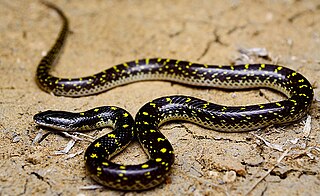
Lycodon flavomaculatus, commonly called the yellow-spotted wolf snake, is a species of colubrid snake found in the Western Ghats of India.
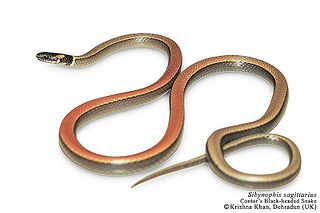
Sibynophis sagittarius, commonly known as Cantor's black-headed snake after Theodore Cantor, is a species of snake endemic to South Asia.

The lesser black krait is a species of venomous elapid snake found in India, Bangladesh, and Nepal. The specific epithet is after Latin lividus, meaning “bluish metal-colored” or “lead-colored”, referring to the snake's coloration.

The greater black krait or black krait, is a species of krait, a venomous snake in the genus Bungarus of the family Elapidae. The species is endemic to South Asia.

Günther's black snake is a species of poorly known lamprophiid snake endemic to central Africa. It is the only member of the genus, Bothrolycus. This snake is notable as one of the few snakes with notable sexual dimorphism, as well as possessing a small pit anterior to the eye. While superficially similar to the thermal pits of vipers, its function remains unknown.
The dwarf beaked snake, also called the western beaked snake, is a species of snake, which is endemic to southern Africa. It is in the monotypic genus Dipsina.

Snakes, like other reptiles, have skin covered in scales. Snakes are entirely covered with scales or scutes of various shapes and sizes, known as snakeskin as a whole. A scale protects the body of the snake, aids it in locomotion, allows moisture to be retained within, alters the surface characteristics such as roughness to aid in camouflage, and in some cases even aids in prey capture. The simple or complex colouration patterns are a property of the underlying skin, but the folded nature of scaled skin allows bright skin to be concealed between scales then revealed in order to startle predators.
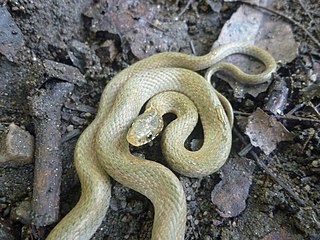
The Japanese keelback is a species of colubrid snake, which is endemic to Asia. It was first described in 1826 by Heinrich Boie as Tropidonotus vibakari.

The Transvaal girdled lizard or Reichenow's spiny-tailed lizard is a very flattened girdled lizard from northeastern South Africa, Eswatini, and southeastern Botswana. It prefers rock outcrops in open grassland and feeds on small arthropods, especially beetles.
Machadoe's girdled lizard is a flattened girdled lizard from southwestern Angola and northwestern Namibia. They are found as solitary individuals or in pairs on rock outcrops in arid savannah. It can be identified, along with Cordylus vittifer, by have an elongate first row of dorsal scales. Machadoe's girdled lizard is uniform yellow brown above and paler below. The head is dark brown with pale lips. The pale vertebral stripe found in the Cordylus vittifer is not present. Adults reach 78 mm in length from snout to vent.
Rhinophis punctatus, or Müller's earth snake, is a species of snake in the Uropeltidae family. It is endemic to the island of Sri Lanka.
Atractaspis leucomelas, or the Ogaden burrowing asp, is a species of venomous snake in the Atractaspididae family.
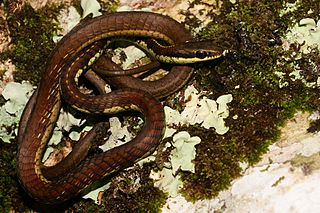
Dendrelaphis schokari, also known as the common bronze-back or Schokar's bronzeback, is a species of non-venomous arboreal snake in the family Colubridae. The species is endemic to Sri Lanka.

Chrysopelea taprobanica, the Sri Lankan flying snake or Indian flying snake, is a species of gliding snake distributed in India and Sri Lanka. It can glide, as with all species of its genus Chrysopelea, by stretching the body into a flattened strip using its ribs. The snake is known as "dangara dandaa - දඟරදන්ඩා" in Sinhala, due to its folding postures.

Wallaceophis is a genus of snake in the family Colubriadae. It was first described in 2016. The sole species is Wallaceophis gujaratensis which is found in the Indian state of Gujarat. Wallaceophis gujaratenisis is presently known from just seven localities of Gujarat and virtually nothing is known about its biology. Common names Wallace's striped snake and Wallace's racer has been suggested for it.
Rhachidelus is a genus of snake in the subfamily Dipsadinae of the family Colubridae. The genus is endemic to South America.
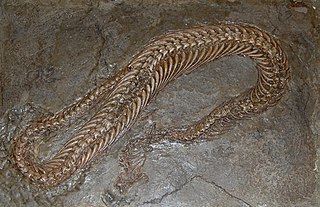
Pachyophis is an extinct genus of Simoliophiidae snakes that were extant during the Cenomanian stage of the Late Cretaceous period. More specifically, it was found to be from the Cenomanian Age about 93.9-100.5 million years ago in the suburb area of Bileca, Herzegovina.















